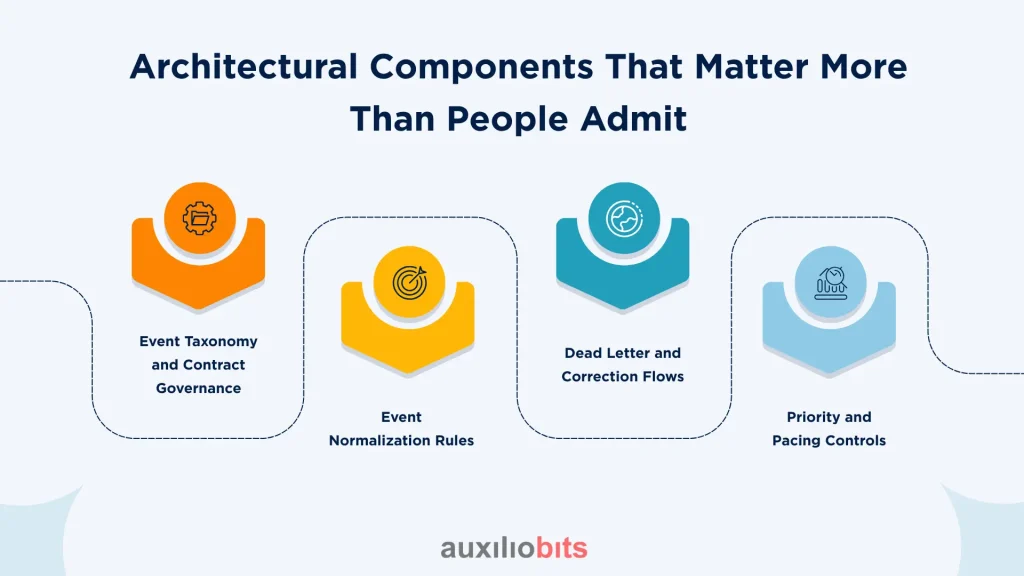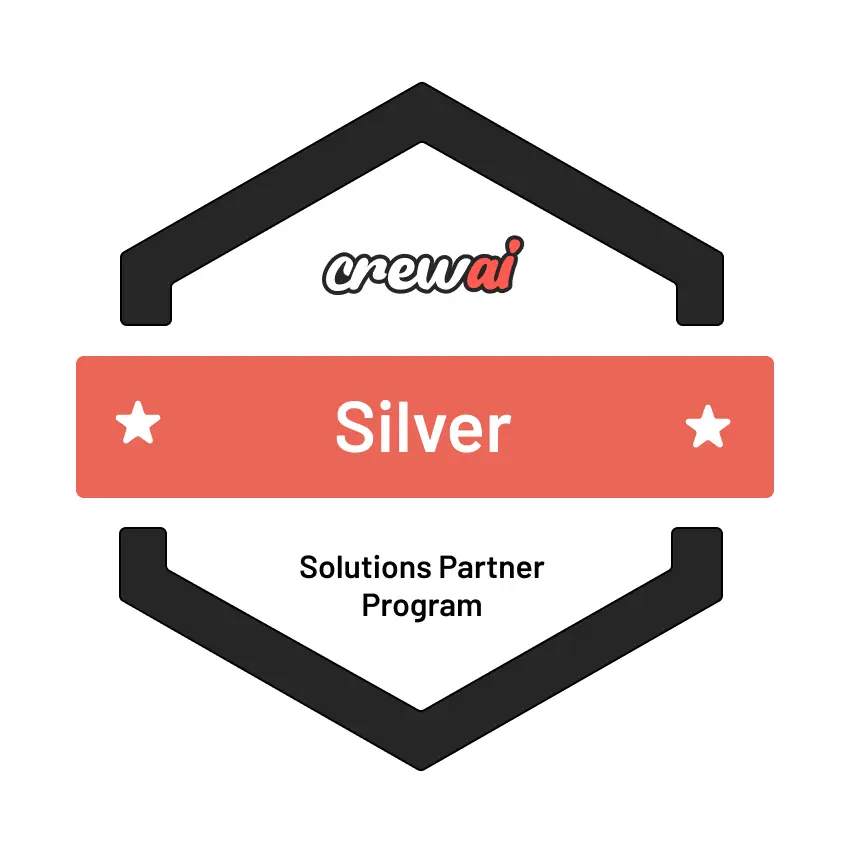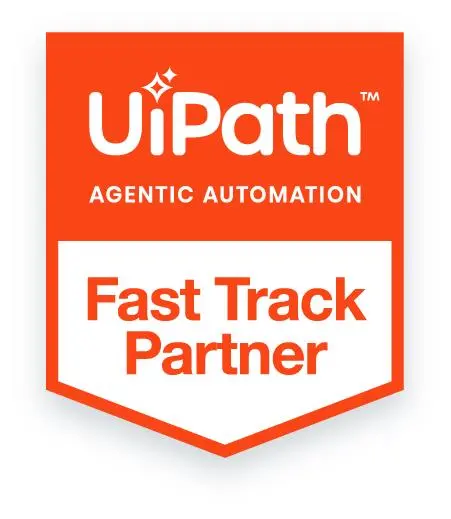
Key Takeaways
- Coordination—not autonomy—is the real bottleneck in distributed agent systems. You can spin up dozens of intelligent agents, but without a stable coordination layer, they conflict, duplicate work, or generate noisy decision cascades.
- Event buses excel because they create a shared environment—not point-to-point dependencies. Agents don’t talk directly to each other; they interact with a common stream of events. This decoupling is what makes multi-agent architectures scale without collapsing under their own complexity.
- Success depends far more on event governance than on the event bus technology itself. Kafka vs. NATS vs. Event Hub is a secondary debate. The real differentiators are the taxonomy, schema discipline, vocabulary alignment, and correction flows built around the platform.
- Autonomous agents introduce new failure modes—semantic drift, inconsistent states, improvisational logic—that require new operational safeguards. Dead letters, validators, supervisors, schema normalizers, and pacing controls become essential to keep agents from misinterpreting or oversharing events.
- Multi-agent ecosystems resemble social systems more than traditional software architectures. Shared language, clear expectations, communication norms, and event transparency ultimately determine how gracefully autonomous agents collaborate at scale.
The moment teams begin experimenting with distributed agents—LLM-driven workers, domain-specific micro-agents, or orchestration bots—they inevitably run into the same realization: autonomy is easy; coordination is not. Anyone can spin up a dozen agents that each make reasonable decisions on their own. The real headache starts when these agents must interact without stepping on each other’s toes, duplicating work, or cascading bad decisions across the ecosystem.
This is where event-driven communication patterns, especially event bus architectures, unexpectedly become the backbone of scalable multi-agent automation. Funny how an “old” architectural pattern finds an entirely new purpose when autonomy enters the picture.
Some CIOs ask whether agents can just “call each other directly.” They can, of course. They can also fight like siblings fighting over one TV remote. Direct RPC-style calls rarely survive even modest production loads once autonomous decision-makers, rather than deterministic services, start driving interactions.
The companies that have built stable, distributed agentic systems—manufacturers optimizing production runs, insurers coordinating claims triage, fintech platforms processing KYC + risk pipelines—almost all converge on some variation of an event bus.
Also read: AI Agents in Strategic Scenario Simulation for Executive Decisioning
Why Coordination Gets Messy with Autonomous Agents
The central challenge is subtle: distributed agents are not merely “microservices that talk to LLMs.” They behave differently. They generate intent on their own, often asynchronously. They act on incomplete information. They retry tasks without waiting for permission. They occasionally improvise pathways nobody designed (annoying, yes… but sometimes brilliant).
When you combine all of that, deterministic orchestration breaks down.
A workflow engine can’t predict what it doesn’t control. A point-to-point API call can’t anticipate decisions that haven’t been made yet. A central orchestrator becomes a bottleneck (and, frankly, a single point of failure for creativity).
An event bus flips the model entirely. Instead of controlling execution, it becomes an information backbone—quiet, passive, but incredibly influential. Every agent listens to specific categories of events, reacts based on its own logic, and emits new signals back into the environment. That’s the entire philosophy: agents interact with an environment, not each other.
And environments only scale through decoupling.
What an Event Bus Actually Provides
Architects sometimes describe event buses in sterile language—“loose coupling,” “publish/subscribe,” “asynchronous processing.” True, all of that is accurate. But the reason event buses work so well with autonomous agents has more to do with behavioral containment.
A good event bus setup provides a handful of guardrails:
- A single source of truth for state transitions, even when decision logic is distributed.
- Guaranteed delivery or at least traceability when multiple workers react to the same stimuli.
- Pacing control, preventing runaway cascades when agents get hyperactive.
- Observability without having to intercept internal agent logic.
- A shared vocabulary for tasks, results, errors, and context.
Most enterprises underestimate that last point. Shared vocabulary matters. If one agent emits “DOCUMENT_PROCESSED” and another expects “DOC_READY,” you end up debugging ghost interactions for weeks. It sounds trivial, but ask any integration architect who inherited a poorly documented Kafka setup—they’ll tell you about their recurring nightmares.
A Quick Reality Check: Event Buses Are Not Magic
Some commentaries praise event-driven systems as if they eliminate complexity. They don’t. They just reorganize it.
You get incredible independence among agents, but in exchange, you must enforce consistency at the event schema level. The moment the schema drifts—new fields here, renamed flags there—your agents begin making questionable assumptions. (And agents making assumptions is how you get delightful surprises… like a “data enrichment agent” suddenly deciding it should also classify the document because the “status” flag looked familiar.)
Another pain point: observability can explode. One client in logistics complained that their event stream produced so much granular output from their agents that they couldn’t distinguish noise from meaningful changes. Their solution? They added another agent—ironically—to summarize events and publish only curated updates. An event-literate auditor agent, if you will.
So yes, event-driven agent coordination works. But it takes discipline.
Architectural Components That Matter More Than People Admit
When enterprises implement an event bus for distributed intelligent agents, they tend to obsess over the platform—Kafka vs. NATS vs. Azure Event Hub vs. RabbitMQ. A heated debate, no doubt. But the platform is rarely the decisive factor. The real differentiators emerge in the layers around it.

1. Event Taxonomy and Contract Governance
This is the intellectual foundation. Not glamorous, but crucial.
- Define domains clearly (e.g., Document Events, Risk Events, Manufacturing Events).
- Assign ownership—someone has to be the “event librarian.”
- Introduce versioning, even if engineers protest.
- Track backward compatibility manually at first; automate later.
Most early-stage agentic projects collapse here—not due to bad code but due to drifting vocabulary.
2. Event Normalization Rules
You’d think agents would emit clean and consistent events. They won’t.
Agents interpret instructions differently. LLM-based agents, especially, often vary phrasing unless you enforce a strict output schema. Normalization layers—sometimes implemented as transformers on the bus—maintain clarity.
3. Dead Letter and Correction Flows
Autonomous units fail in weird ways. Not like typical microservices.
A “semantic misunderstanding” creates error classes that operational teams are not used to:
- Events with contradicting fields
- Events that describe impossible states
- Events missing semantic context (because an LLM agent “forgot”)
Instead of throwing these away, enterprises often route them through correction agents: validators, supervisors, or reconciliation services.
4. Priority and Pacing Controls
When agents broadcast too frequently, event storms hit the system. When they broadcast too slowly, the orchestration lags. When multiple agents react to the same event at once, you get race conditions.
A sophisticated event bus allows:
- Rate limiting
- Partitioning
- Replay isolation
- Priority-based consumption (claims events > marketing events, for example)
This becomes essential once you cross more than 15–20 active agents in production.
Patterns That Work in Enterprise Agent Systems
A few patterns have become almost standard among organizations coordinating distributed intelligent workers. They aren’t “best practices”—just what repeatedly proves sane.
Instead of central schedulers, a simple rule-based dispatcher agent listens for work events and publishes subtasks. Other agents “bid” by emitting readiness or capability responses. Lightweight, resilient, and surprisingly fair.
Used by: An insurer coordinating AI agents for FNOL (first notice of loss) triage.
A separate service keeps track of each agent’s current “public state,” such as:
- Busy
- Idle
- Suspended
- Awaiting approval
The agents themselves update the mirror as an event stream. Human supervisors use this layer to control the collective without interfacing directly with any individual agent.
Pattern C: Post-Processing Supervisors
After agents execute actions, a guardian agent validates outcomes—cross-checking business rules, missing data, or anomalies. This prevents agents from silently drifting outside compliance boundaries.
Seen in: Global banks regulating automated risk evaluations.
Rather than passing massive payloads between services, agents attach context tokens or references. Downstream services pull the necessary information only when required. It keeps the bus lean and reduces over-sharing of sensitive data.
Where Event Buses Shine for Multi-Agent System
Some environments reveal the true power of event-driven coordination. Three stand out.
1. High-Variability Business Processes
Claims management, credit underwriting, procurement exceptions—these processes never behave the same way twice. Autonomous agents thrive here because event buses let them self-organize around irregular, unpredictable inputs.
2. Hybrid Human–Machine Workflows
When humans approve, escalate, or override decisions, events become a neutral meeting point. Humans don’t need to know agent internals. Agents don’t need to know UI logic.
Events act as a lingua franca.
3. Large Enterprises with Existing Systems Entangled Everywhere
In retail or manufacturing environments with dozens of legacy platforms, an event bus adds a thin connective tissue. Agents don’t need to talk to SAP directly; they just react to the events that an SAP connector publishes.
The more heterogeneous the systems, the more event-driven design helps.
Where Event Buses Can Be Painful
Not every architecture benefits equally. Some scenarios struggle.
Event buses introduce propagation delays. Not huge, but noticeable for high-frequency trading, ledger updates, or millisecond-sensitive operations.
If teams can’t maintain event contracts reliably, introducing agents that generate events autonomously is like adding fuel to an already unstable fire.
Overengineering shows up fast. If your “multi-agent system” is three scripts automating an Excel workflow, an event bus is an unnecessary ceremony.
Five Practical Recommendations
Not theory. Not academic patterns. Actual lessons extracted from enterprise systems.
- Treat every agent like an unreliable narrator: They will occasionally misinterpret schema. Validate everything.
- Build event schemas around business verbs, not technical nouns: “InvoiceReviewed” travels better across systems than “ocr_pipeline_complete.”
- Implement event replay strategy early: Agents that reprocess old events should not accidentally duplicate work.
- Add correlation IDs that survive across agents, humans, and systems: Observability will crumble without them.
- Design for overload, not average load: LLM-based agents sometimes emit bursts of decisions. The bus needs to absorb shock waves.
Multi-Agent Systems Are More Social Than Technical
Architects sometimes forget that autonomy turns software into a community. Agents negotiate. They wait. They react emotionally—well, not technically, but LLMs produce patterns that might as well be emotion-like. They collaborate and occasionally clash.
Event buses allow this emerging society to function without central policing.
The closest analogy is the shift from monolithic organizations to distributed teams. Communication patterns matter as much as skill. Over-communication leads to chaos; under-communication leads to silos. The same dynamics appear in agent-driven ecosystems.
And just like in human organizations, the healthiest environments use:
- clear expectations
- shared language
- respectful boundaries
- transparent communication channels
Strange how software echoes sociology when autonomy enters the mix.
Final Thoughts
Event bus architectures aren’t glamorous. Nobody gets promoted for “great work on event schema governance.” Yet, if you look underneath the most stable multi-agent systems being deployed today—from aerospace manufacturing digital twins to autonomous underwriting desks—you’ll find the same quiet mechanism keeping everything aligned: a well-governed, event-driven coordination fabric.
Distributed agents don’t need a boss. They need a place to talk. The event bus becomes that place.
And whether we admit it or not, the quality of that conversation determines how far enterprises can really scale autonomous collaboration.








